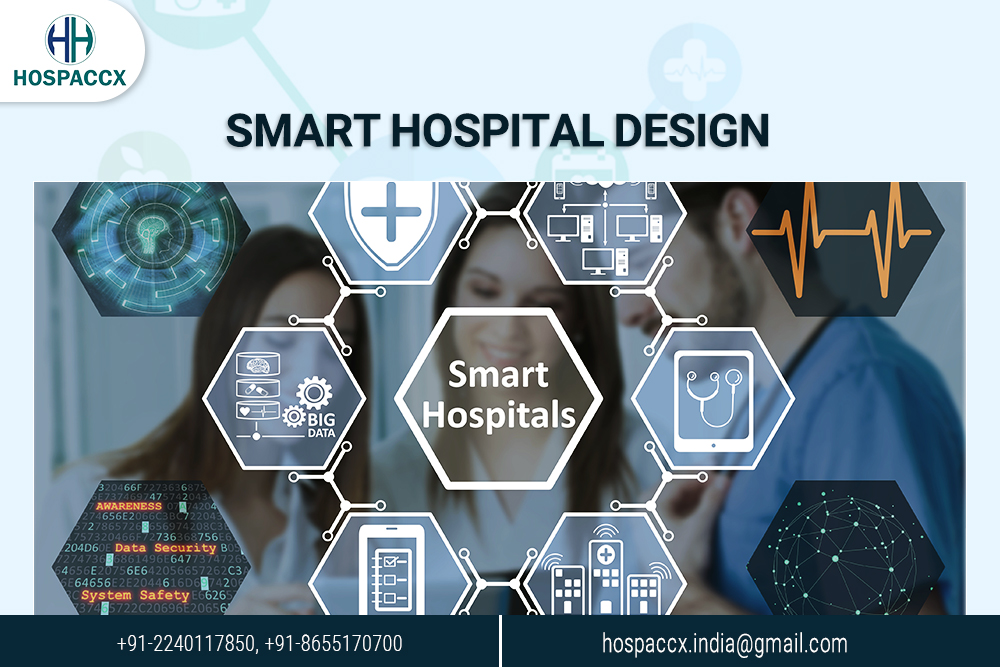INTRODUCTION
Smart hospitals are those that optimize, redesign or build new clinical processes, management systems and potentially even infrastructure, enabled by underlying digitized networking infrastructure of interconnected assets, to provide a valuable service or insight which was not possible or available earlier, to achieve better patient care, experience and operational efficiency.
Considering the above facts, Hospaccx team participates in the market trends and dynamic of smart OT design. This is macroficial study of Smart Hospital Design if you want to get into more detail you can contact info@hhbc.in
SMART HOSPITAL DESIGN FACILITY
The use of natural light, softer lighting, nature inspired artwork and music has a positive impact on speedy recovery of patients
• Space management design: Flexibility of furniture, use of multipurpose furniture, spacious and warm waiting areas helps in creating functional and comforting environment.
• The design should optimise staff travel distances, patient safety, ease of communication and proximity of patients to nurse stations.
• Playful yet relaxing room design and distraction techniques can be used to help patients through critical treatments without sedation.
HOW TO DESIGN SMART HOSPITAL
1. Check-in kiosks
Patient kiosks can be implemented and offer the added advantage of introducing patients to digital connectivity. A patient kiosk offers a convenient, on-site method of interface that patients can use to access a self-service system.
Check-in can be completed at any kiosk, or patients who have completed online appointment registration can simply scan their phone or a printout for identification and check in by using the kiosk’s barcode check-in feature. A patient-flow management system that will track room availability and ultimately reduce wait time. The entry sequence of the floor is designed so the kiosks are a central focal point between the elevator lobby and the circulation stair but are still adjacent to open staff workstations in case assistance is required.
2. Connective furniture
Many patients and family members sitting in waiting rooms use personal mobile devices for entertainment, to review and update personal health information, or to make payments and arrange future appointments.
Institutions must accommodate this constant interaction via mobile technology—and find ways to utilize the connectivity to their advantage. By enhancing waiting rooms with connective furniture—augmented with outlets for charging—and a robust Wi-Fi system, patients and their families can experience a new level of comfort and convenience not typically associated with healthcare facilities.
Connectivity should be considered at the very beginning of a project and utilized as a planning resource to help direct the program and, ultimately, the design.
3. Hybrid exam/consult modules
As technology allows to add or expand options for diagnostic, clinical, and customer services, technology also allows the opportunity to rethink standard spaces to create a streamlined, optimized environment. The development of exam/consult modules can eliminate assigned, or physician-specified, rooms, creating overlap between different clinical spaces. This overlap allows the use of a digital scheduling system to flex between available rooms, thus optimizing usage and reducing wait times.
Hybrid exam/consult rooms—interconnecting the adult and pediatric clinical spaces—are designed to increase patient comfort and personalize doctor-patient interaction.
4. Education zones
Education zones dispersed throughout clinical areas can introduce patients to the use of devices that monitor their condition, teaching them how to interpret and utilize real-time device-generated information.
Home scales and glucose monitors connected to the patient portal will update patient records daily and alert doctors of any important issues. Likewise, the information collected from the monitors is well documented in order to keep the option of retro analysis available to patients and doctors.
5. Telemedicine
Current technology enables doctors and patients to connect remotely and share information in a variety of ways, through two-way video, email, smart phones, wireless tools, and more. All classrooms and conference rooms must be designed with interactive video conference capability, giving physicians the opportunity to work remotely with patients or provide information to family members, while both callers view the same information on their individual screens.
6. EMR scanning room
While electronic medical records (EMR) become the standard, some healthcare facilities are still in transition. A large room created with space for EMR scanning equipment and the storage of medical records, this transition is underway. When the scanning is complete, the room is designed to be repurposed. Scanning equipment and files will be removed and replaced with conference furniture and systems to support telemedicine.
7. Interactive features
Technology can entertain and stimulate while it educates—a critical tool in the planning and design of pediatric healthcare environments, especially. The overall goal of the installation is to promote movement, an important prevention method for pediatric patients, through custom-designed interactive games that will be simultaneously entertaining and educational.
BENEFITS OF SMART HOSPITAL
1. Improve patient satisfaction: Mobile applications from a bedside tablet can be tied into the building management system to give patients control over their own room temperature and lighting, as well as the ability to call the nurse, view noise levels, and control their smart TV..
2. Protect patient health: Proper air movement can reduce the transmission of healthcare-acquired infections (HAIs) and can be an effective measure to promote patient safety and healing. The normal air flow design is based on air changes an hour (ACH); however, WHO suggests that in order to reduce infections, air flow should be designed per patient. This WHO guideline recommends 60 liters per second per patient in general wards and outpatient departments. That figure is easier to achieve with intelligent infrastructure automating the process.
3. Stay current: Technology is evolving so fast and hospitals are notoriously slow in adopting the latest and greatest. And that’s because it’s no small challenge to incorporate new technology, as hospitals are complex facilities. A digital infrastructure is built to be open, flexible, and scalable so that it can accommodate future technologies and expansions.
4. Enhance productivity: A digital infrastructure utilizes forward thinking network connectivity to enhance wireless communication and transfer of digital data such as electronic medical records and digital imaging. Being able to access patient information remotely through smartphones and tablets enables hospital staff to react efficiently and quickly, improving not on productivity, but also patient care.
7. Protect them like they are your own:With a digital, intelligent infrastructure, hospital security teams can integrate video surveillance, access control, intercom, intruder detection, fire safety, RTLS, among other security systems to provide real-time data and alarms. In addition, in the event a security incident occurs, actionable reports with traceability are available for forensic analysis.
CONCLUSION
The automation of the healthcare sphere is one of the most urgent and, perhaps, the most difficult tasks. A huge amount of money is spent to solve it. The Smart Hospital concept is aimed at creating a single IT environment composed to automate specialized and auxiliary processes of hospital
Are you planning to design your healthcare organisation? We can help you to design your dream project, below are the healthcare design services that we offer:-
- Healthcare Architecture Design services
- MEP Design
- Landscape Design services
- Structural Design services
- Interior Design services
It is the superficial and macro level study for more details kindly contact Hospaccx Healthcare business consulting Pvt. ltd on hospaccx.india@gmail.com Or you can visit our website on https://hospaccxconsulting.com/
Related Team Members





















